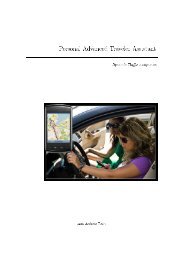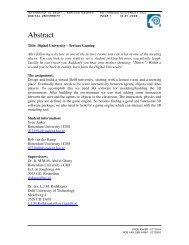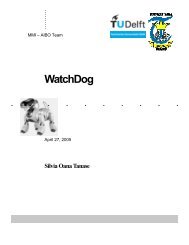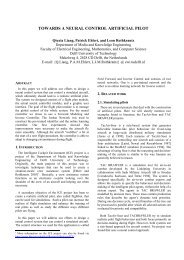Recognition of facial expressions - Knowledge Based Systems ...
Recognition of facial expressions - Knowledge Based Systems ...
Recognition of facial expressions - Knowledge Based Systems ...
You also want an ePaper? Increase the reach of your titles
YUMPU automatically turns print PDFs into web optimized ePapers that Google loves.
IMPLEMENTATION<br />
Facial Feature Database<br />
In the process <strong>of</strong> preparing the reasoning component to perform a reliable classification<br />
<strong>of</strong> <strong>facial</strong> <strong>expressions</strong>, data concerning visual features <strong>of</strong> the human face had to be<br />
available. All the relevant information had to be extracted from the image data and stored<br />
in a proper format. The reasoning methods used in the experiments consisted in statistical<br />
analysis, as Principal Component Analysis, neuronal networks and probabilistic<br />
techniques, as Bayesian Belief Networks. The PCA method was used for deciding what<br />
class <strong>of</strong> emotion can be assigned for some given image structure <strong>of</strong> certain <strong>facial</strong> areas,<br />
such as for the chin, the forehead and nasolabial areas. The other techniques were used<br />
for directly mapping an entrance <strong>of</strong> parameter values to certain groups <strong>of</strong> outputs, as<br />
Action Units or/and <strong>facial</strong> <strong>expressions</strong>. In all the cases, the values <strong>of</strong> some parameters,<br />
according to the chosen model for recognition, were manually computed from the Cohn-<br />
Kanade AU-Coded Facial Expression Database. Subjects in the available portion <strong>of</strong> the<br />
database were 100 university students enrolled in introductory psychology classes. They<br />
ranged in age from 18 to 30 years. Sixty-five percent were female, 15 percent were<br />
African-American, and three percent were Asian or Latino. The observation room was<br />
equipped with a chair for the subject and two Panasonic WV3230 cameras, each<br />
connected to a Panasonic S-VHS AG-7500 video recorder with a Horita synchronized<br />
time-code generator. One <strong>of</strong> the cameras was located directly in front <strong>of</strong> the subject, and<br />
the other was positioned 30 degrees to the right <strong>of</strong> the subject.<br />
Only image data from the frontal camera were available at the time. Subjects were<br />
instructed by an experimenter to perform a series <strong>of</strong> 23 <strong>facial</strong> displays that included<br />
single action units (e.g., AU 12, or lip corners pulled obliquely) and combinations <strong>of</strong><br />
action units (e.g., AU 1+2, or inner and outer brows raised). Subjects began and ended<br />
each display from a neutral face. Before performing each display, an experimenter<br />
described and modeled the desired display. Six <strong>of</strong> the displays were based on descriptions
















